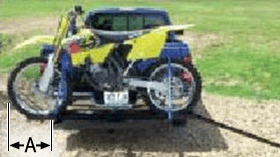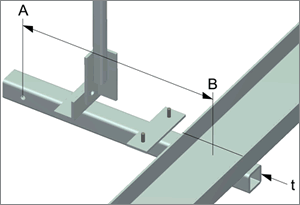Safe Cycle Hauling
Safely Hauling Your Cycle
WARNING OF WEAK/UNDERSIZED RECEIVER TUBES OR UNKNOWN STEEL PROPERTIES
MOTORCYCLE RACKS/MOTORCYCLE CARRIERS
Ask your carrier manufacturer for the actual wall thickness of the 2” receiver tube. This is the critical component that supports the entire load!
 ‘A’ 15-17″ offset creates excessive twist on receiver tube and hitch. This carrier is available for sale! Offset by design, this imbalance is a source of great torsional stress on carrier and vehicle. The better cycle carriers have inherent balancing and adjustment on the left to right and front to rear to keep the motorcycle properly balanced and close to back of the vehicle.
‘A’ 15-17″ offset creates excessive twist on receiver tube and hitch. This carrier is available for sale! Offset by design, this imbalance is a source of great torsional stress on carrier and vehicle. The better cycle carriers have inherent balancing and adjustment on the left to right and front to rear to keep the motorcycle properly balanced and close to back of the vehicle.
Motorcycle carriers/hitch racks just like vehicles have structural limits based on loading requirements and expected life. Factors like deterioration due to corrosion, damage from abuse, shock from rough roads, and overloading are not always considered by the manufacturer or end user of the products.
The manufacturer’s makes design assumptions about the hitch products, how they’ll be used and how often they will be used i.e. for extended use, limited use, or a one time use.
For extended use, motorcycle carriers i.e. loading of the carrier to rated capacity and using the motorcycle carrier for many trips(many hundreds or a few thousand miles), the receiver tube must be made of the proper material and a minimum wall thickness for a successful and trouble- free life. Also consider that any manufacturing defects or poor workmanship i.e. manufacturing notches, weld undercut, excessive internal stresses due to excess welding heat input/distortion or inferior steel can significantly reduce the receiver tube’s life. Other factors to consider are excessive twist (torsion) and bending due to bouncing over rough roads, overloaded/damaged vehicle suspensions, carriers that have not been located on center by design, and manufacturing errors. Also, some motorcycles are designed with the center of gravity not at the midpoint of the bike. These factors can contribute to excessive loading which is compound in nature (bending plus torsion) and can significantly reduce the receiver tube’s expected life.

|
Load at 19″ from pin (A) to center of tray (B). Receiver tube (t).
|
||
| Recommended max. weight/static load |
A500 square structural tube (t) wall thickness of 2″ tubing |
Typical hitch classifications (max.) |
|
250 lbs
|
1/8″ (11 ga.)
|
2
|
|
500 lbs
|
3/16″(7 ga.)
|
3
|
|
1000 lbs
|
1/4″
|
4
|
LOW PRICED/UNDERSIZED HITCH RACK PRODUCTS
The following products have been found to have undersized/weak tubes based on the above considerations. This product is manufactured in China of questionable steel for the receiver tube.
USE AT YOUR OWN RISK!! MAYBE IT WILL MAKE IT ON ONE TRIP?
- AMC400
- RATED Load: 400 LBS
- Receiver tube thickness: 1/8
- Recommended max load: 200 lbs
*other thin/weak bracket elements on the unit lowers the rating.
